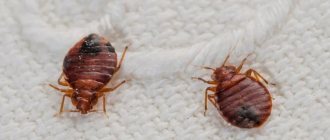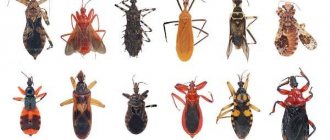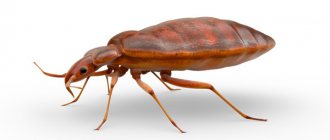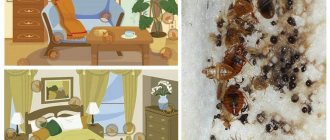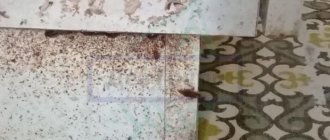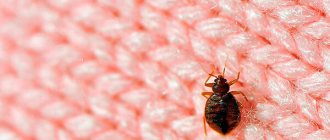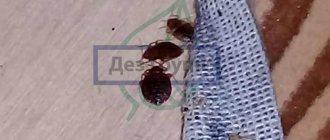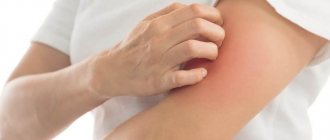Bedbugs can cause a lot of inconvenience to people. These ectoparasites feed on human blood, attacking victims mainly at night, so they set up their colonies where they can easily access food. Finding insect bites on the body and face in the morning, people often wonder whether bedbugs can live in pillows or blankets.
Bed bugs are blood-sucking parasites that feed on human blood.
Where do bedbugs most often live?
Bed bugs prefer to live in warm, dry places where there are holes and enough air.
Most often, insects can be found on the back walls of beds and sofas, inside mattresses, in armrests, sofa cushions, and ottomans. Their favorite material is foam rubber, since it is convenient to lay eggs in its pores.
In addition to upholstered furniture, ectoparasites are found:
- in the cracks of wooden furniture;
- for batteries;
- in picture frames;
- under baseboards;
- in the bedside table;
- inside sockets and electrical appliances;
- between books on shelves;
- in the carpet pile;
- under linoleum;
- under the peeling paint on the wall.
Parasites are found in the cracks of wooden furniture and beds.
Can bedbugs live in pillows?
It is extremely rare for bedbugs to settle in pillows, since the fillings of these bedding items are made from bulk materials in which insects cannot move freely and lay eggs. At night, parasites emerge from secluded places where they hide during the day.
They crawl onto the pillow where a person sleeps to feed on his blood, and then return to their colonies.
Feather
Feather bedding can become a habitat for ectoparasites only if its filling is not cleaned for a long time. Feathers are not a suitable material for insects because they tend to clump and hinder their movement. In addition, feather pillows have thick pillowcases through which bloodsuckers cannot crawl inside the product.
Pillows and blankets can become habitats for bedbugs.
Pukhovs
Down, like feathers, cannot be called a suitable habitat for bedbugs. But if the filling of down pillows is not cleaned and dried, these insects can live in it, especially when there are a lot of them in the house.
Where do bed bugs come from in a mattress?
A close source of food is one of the important factors for the successful life of parasites, therefore the place where a person sleeps is ideal for arranging a nest. A colony begins to develop here. Only when it increases significantly will insects look for other shelters.
Parasites enter the house in different ways, so when bedbugs appear in an old mattress, although it is unpleasant, it is understandable. But when a new product turns out to be infected, it often causes confusion. If the first signs of the presence of insects became noticeable immediately after acquisition, then:
- sometimes it happens that mattress bugs were brought from a warehouse, this is unlikely, but it happens;
- workers could bring bedbugs if the room was renovated before purchasing the mattress;
- the insects were brought by the owners from a trip: this often happens when things are not washed upon return, but are immediately placed in the closet.
From the trip
We must not forget about the more common methods:
- migration from neighbors in apartment buildings;
- passive migration on a person’s clothing or the fur of a pet that is on the street.
What to do first
First you need to make sure that there are blood-sucking parasites in the bedding or other places.
Their presence is indicated by:
- traces of insect activity, resembling dark-colored dots, on the surface of the bed;
- blood stains on pillowcases and sheets;
- the unpleasant smell of fermented raspberries emanating from the bedding;
- red itchy spots on the skin, located sequentially (appear after sleep).
Make sure that your sleeping areas are infested with blood-sucking parasites.
If these signs are detected, you need to take measures aimed at exterminating the bedbugs.
How to find bedbugs in a mattress?
At the first suspicion of the appearance of insects (characteristic bite marks, blood stains on the sheet), it is necessary to examine the mattress. Most often, the remains of their vital activity can be found on the reverse side, but the presence of nests in the product itself cannot be ruled out. Proximity to food and inaccessibility during cleaning make the shelter ideal.
First of all, you need to remove the mattress cover, take it into the washing machine in a bag and wash it at a temperature above +600C. The integrity of the upholstery and seams are checked, since bedbugs cannot get inside the mattress in any other way. Their size does not allow them to penetrate the fabric.
The main signs that parasites have settled in the product:
- remains of traces of bedbugs in the form of small black grains;
- the presence of scales from the chitinous shell, which the larvae shed at the seams and near the gap;
- yellowish stains on fabric upholstery;
- unpleasant sweetish smell that comes from the mattress.
Despite the fact that bedbugs do not like artificial materials, they can also live in foam rubber, especially if it is covered with natural cotton.
How to get rid of insects
To get rid of blood-sucking insects, different methods are used: mechanical, folk and chemical. Their choice depends on the preferences of the home owners, the number of parasites and other nuances.
Mechanical method
Since ectoparasites are found in bedding due to poor hygiene, you can get rid of them by cleaning the pillow. To do this, you need to undo the seams on the pillowcase, take out the filling and clean it. At home, this is most conveniently done by washing in hot water (from 50 °C) or steam treatment. The pillowcase should be washed and ironed thoroughly, paying special attention to the seams, as parasite eggs may remain in them. The dried filling is placed in the pillow, and the pillowcase is sewn up.
Washing and steaming will help get rid of insects that have infested a wool blanket. If pillows and blankets cannot be washed, they should be taken to the dry cleaner.
This method of fighting bedbugs is considered the simplest and least effective. To achieve the result, it must be carried out in parallel with chemical treatment of places where insects most often settle (the back of sofas, furniture crevices, etc.).
The mechanical method is the most effective.
Traditional methods
If you don’t want to use toxic chemicals in your home, you should try to get rid of bedbugs using the methods you used before:
- Dry or fresh branches of wormwood and tansy should be placed under the bed, on bedside tables and in other places where parasites accumulate. These plants are non-toxic, but bedbugs can't stand their smell, so they won't hang around them.
- In winter, you can try to freeze out the parasites. To do this, pillows and blankets must be left outside for 2-3 days at temperatures above -10 °C. Freezing destroys the adults and their eggs. In the summer, this method can also be used if you place the products in the freezer for several days.
Chemicals
Traditional methods will be effective if there are no large colonies of parasites in the house. When there are a lot of bloodsuckers, chemical industry products will come to the rescue.
"Delta Zone"
Belongs to the category of low-toxic drugs. It is produced in the form of a microencapsulated suspension based on deltamethrin 2.5%, which must be diluted with water in accordance with the instructions. The product destroys adult insects, larvae and egg laying. Valid for 8 weeks. It has no unpleasant odor and does not pose a danger to people, animals and plants. The drug does not leave burns or other marks on the skin. After disinsection treatment, you need to ventilate the room for 30 minutes.
“Delta Zone” is an insecticidal agent that is intended to kill bedbugs.
"Get Total"
Microencapsulated insecticide in the form of a solution intended for dilution in water. The active ingredient of the drug is chlorpyrifos, a substance that has a toxic effect on bed bugs and other harmful insects. "Get Total" destroys parasites within 2 and a half hours after direct spraying and remains on surfaces for 3-4 days, continuing its effect.
Thanks to this, there is no need to carry out repeated disinfestation. The product has no toxic effect on people and animals.
"Executioner"
A highly concentrated solution whose insecticidal effect is provided by fenthion. Designed for direct spraying. If the drug gets into the spiracles, bed bugs live no more than 8 and a half minutes. After drying, it remains toxic for 19 hours.
“Executioner” is a modern remedy, quite effective.
“Executioner” has a specific smell, which disappears after airing. You can return to the room where the drug was treated after 2 hours. The dried solution remaining on surfaces after applying the product contains a minimal amount of fenthion and is not dangerous for people and animals.
"Pyrethrum"
A distinctive feature of “Pyrethrum” is its naturalness. The drug is based on dried Dolmat chamomile flowers and is produced in the form of a powder intended for preparing a solution. It is toxic to all crawling insects, but is safe for humans and animals. This organic insecticide upon contact causes paralysis of the nervous system of parasites and their death.
The solution prepared from the powder has a pleasant floral aroma. After treatment, the room may not be ventilated. Toxic substances contained in Pyrethrum disintegrate in air and do not require rinsing off.
"Combat SuperSpray"
Aerosol “Combat SuperSpray” destroys bedbugs and their clutches thanks to the substance imiprotrin. Has a fruity smell. Easy to use: just spray on insects and also treat their habitats. The manufacturer promises instant destruction of parasites and prolonged action. After disinsection, the room should be ventilated for half an hour. "Combat SuperSpray" is allowed to be used in residential premises.
“Combat SuperSpray” is a Korean broad-spectrum insecticide.
"Xulat Micro"
The insecticide is available in the form of an odorless suspension that is safe for people and pets. Immediately 3 active components in the composition of the drug (tetramethrin, cypermethrin and piperonyl butoxide) have a paralyzing effect on ectoparasites and cause their death after 30 minutes. The drug may not be removed from surfaces, in which case it will prevent the appearance of bedbugs for another six months.
"Cucaracha"
Concentrated solution "Cucaracha" contains FOS-malathion and pyrethroid-cypermethrin. Thanks to the action of 2 components, the drug destroys bedbugs within an hour after disinfestation. It has an unpleasant odor, so you need to use it with a respirator and with open windows. After treatment, it is necessary to ventilate the room for 3 hours and carry out wet cleaning using a soap-soda solution. There is no need to rinse off the product in crevices and other hard-to-reach places.
“Cucaracha” is a concentrated solution for bedbugs.
"Cifox"
Cypermethrin concentrate "Cifox" is highly effective in fighting bedbugs, but due to its toxicity it is undesirable to use it in residential areas. If you decide to fight parasites using this product, after disinfestation you need to thoroughly wipe all treated surfaces and ventilate the room.
Use of insecticides
When fighting bedbugs using chemicals, it is imperative to take precautions. When treating your home, you need to protect your respiratory system with a respirator or gauze bandage, and your hands with rubber gloves: the toxic substances in these preparations have a detrimental effect not only on pests, but also on people.
To prevent chemicals from coming into contact with exposed areas of the body, it is necessary to wear protective clothing. It is also better to cover your head with a cap. After treating your home, you should wash your face and hands well with soapy water, change clothes and go out into the fresh air.
The “Get” suspension is odorless and effectively exterminates bedbugs in the house.
Today, a huge number of different insecticides for bed bugs are sold. Chemical preparations are produced in the form of special solutions, gels, emulsions and sprays. The following remedies will help get rid of bedbugs:
It is necessary to carefully select insecticides for self-removal of insects. It should be remembered that chemicals used for a long time may not bring the desired result, since parasites may gradually develop immunity to them.
This is interesting: there are bedbugs in the sofa, what should I do?
How to choose a method for treating bedding against bedbugs
When processing pillows and blankets, preference should be given to methods that do not harm the health of the residents of the house. It is recommended to resort to mechanical and folk methods, and if their action is not enough, then use chemicals. When choosing the latter, you should avoid treating your sleeping area with toxic drugs such as Cucarachi and Tsifoxa, since they can cause headaches, vomiting and other signs of toxic poisoning in the bedroom inhabitants.
It is better to use odorless insecticides with proven safety for human health.
